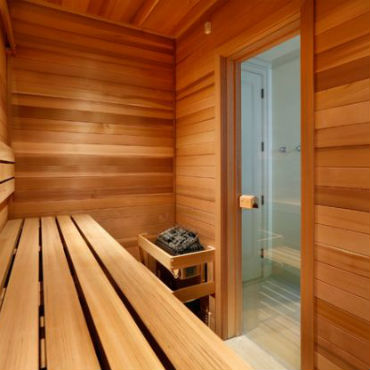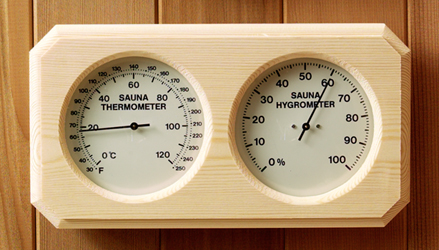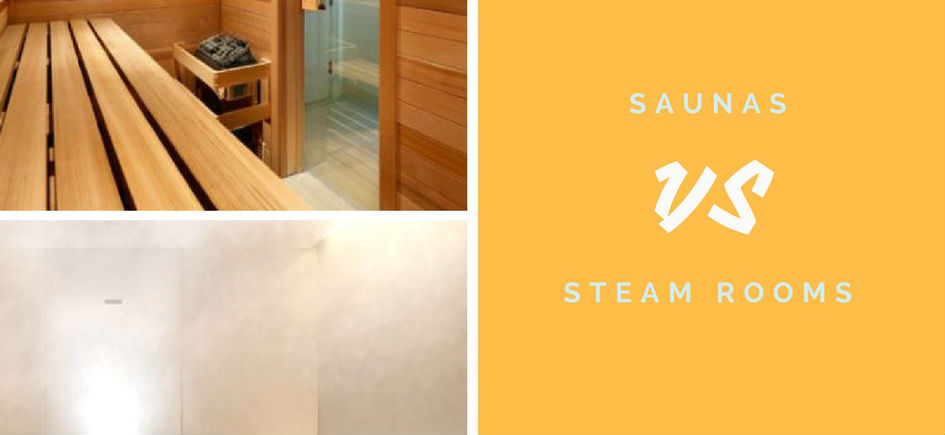Sauna

Steam Room

Temperature: A traditional sauna usually runs somewhere around 160°F, all the way up to 212°F. This is much hotter than an infrared sauna, which typically runs around 120°F to 140°F.
Temperature: A steam room usually operates at a temperature somewhere around 105°F but can sometimes top off at around 110°F to 120°F, much closer to the temperature of an infrared sauna.

Humidity: A traditional type of sauna will have anywhere between 5% to 30% relative humidity, where as in infrared sauna will have only the amount of humidity that is found in the air.
Water can be added to a traditional sauna on top of the rocks to create humidity in the room.
Humidity: A steam room will have 100% humidity at nearly all times because of the steam that is produced. It makes for a much wetter environment and often times seems hotter than a sauna.
The moisture that is created inside of a steam room does not allow perspiration to evaporate either.
Cost: Kits are available and range in price from $1000, all the way up to $20,000 or more depending on size and options. Traditional saunas tend to be higher in price than infrared saunas.
Building your own sauna room and adding a sauna heater to that room is probably one of the most cost-effective ways of having your own personal sauna and is usually significantly less than some of the higher-end kits out there.
Cost: Steam kits are usually in the form of a shower type enclosure and are a little bit less than traditional sauna kits and are priced more competitively with the infrared sauna kits.
To save a ton of money, you could build your own room or enclosure and simply purchased a steam producing heater for a fraction of the price that some steam shower enclosures cost. The kits cost anywhere from $1,000 - $10,000 and up.


Power Supply: Infrared Saunas will usually have a 120 V hookup in the smaller models will work on standard outlets most of the time but most manufacturers recommend having a dedicated breaker and outlet for the sauna.
Most traditional type of saunas will need a 240 V electrical supply line going to them because the heaters require a little more energy than the infrared models. These will have to be on a dedicated line as well.
Power Supply: The steam showers or steam room heaters I found typically run on 120 V and are recommended to have their own dedicated power supply, just like the saunas. It is safer and more efficient to do it this way, just be aware of the extra work and cost involved.
The steam shower kits that had larger steam generators did require a 240 V supply line, just like the traditional sauna heaters. These will also have to be dedicated supply lines on their own breaker.
How It Works: An infrared sauna uses infrared heaters that penetrate the skin and . You must be pretty close to the heaters to absorb their heat though.
A Traditional sauna uses a special heater that heats rocks and the space around it. Water can be poured on the rocks to create humidity in the room.
How It Works: Steam rooms/shower enclosures are a sealed room that uses a steam generator to produce steam in that space.
They run off of either a 120V or 240V connection, depending on the model, size of the room, features, etc. Most person steam rooms are 120V models.



Design: Kits are pretty distinct and many different variations are available. Barrel shaped saunas, standard looking architecture, translecent models and others are available.
Infrared model that are designed for interior use also have different variations when it comes to design.
Design: Steam rooms/showers that come in kits have one common design and they are really made to blend in with existing bath rooms more than anything, not a huge selection of designs available.
If you happen to build your own you can have a little different architecture than what's on the market today.
Prep Time: A traditional sauna takes the longest time to heat up which is usually around 30 to 40 min. for a 165°F room and roughly 60 min. for the temperature to reach 190°F.
An infrared sauna takes roughly 30 to 35 min. on average to heat up to temperatures around 110°F to 130°F.
Prep Time: A steam shower or room will take about 3 to 6 min. to fill up with steam and a total of 10 to 20 min. to reach the ambient temperature of the steam in the room.
Steam showers/rooms are much quicker than saunas but do not get as hot either, something to keep in mind.
The time it takes to heat up an area is dependent on several factors and may very do to climate conditions, heater size, room size of the sauna or steam shower, etc.
Resources:[almost heaven saunas] [amerec.com] [evolutionhealth.com]
Safety Precautions: These are pretty general in nature and are very similar for both saunas and steam rooms so I decided to put them all in one list instead of two separate ones because of how similar they are.
- Before entering a sauna or steam room you should avoid any type of alcohol, sugary drinks or caffeine. Some of these can be dangerous and even life-threatening, especially for people who have pre-existing medical conditions.
- Drinking plenty of water before, during and after a sauna or steam bath session can help prevent dehydration and ensure that your body retains plenty of water during the process.
- Remember that jewelry tends to heat up very quickly and can actually cause mild to moderate burns on your skin if you're not careful.
- If at any time you feel dizzy, faint or abnormal in any sort of way you should exit the sauna or steam bath immediately.
- It is recommended that you consult your physician before entering a sauna or steam room especially if you have medical conditions that could cause serious problems.
- Great article on infrared/traditional sauna & steam room safety
Running cost is basically broken down by calculating the price per kilowatt hour of your electricity and plugging that number into the type of heater you have and the amount of time you spend in the sauna or steam room.
Larger sauna heaters and steam generators are going to use more electricity and be more costly than smaller units and the size of your room will also dictate how long it takes them to warm up and ultimately how long that heater or steam generator is running.
Running Cost: It would roughly cost $.05-$.10 per use to use an infrared sauna at a rate of seven cents per kilowatt hour.
It would cost approximately $.40-$.50 in price to use a traditional* at the same kilowatt hourly rate.
Running Cost: Using a steam room or steam shower is quite inexpensive and is calculated by water usage and power usage combined.
It will cost the average person somewhere between $.10-$.25 per steam session based on average usage metrics.
It is hard to determine the exact costs of a sauna or steam room when operating them but you can expect to pay somewhere around $.10-$.75 per use, on average.
Resources:[ecosteamroom.com] [saunafin.com] [finnleo.com [celebrationsaunas.com]
Duration Of Use: The amount of time you spend in a sauna or steam room will depend on a couple of different variables but sessions for both never usually run longer than 30 or 45 min. in length.
You will want to build up your immunity in a sauna or steam room before you commit to staying inside of one for extended periods of time. A lot of users actually will take a break one or two times during the session and have a cold shower in order to cool the body off and allow it to rest for a little bit.
I found a great article that explained some of the basics on this in a little bit more detail to get a better idea of what to expect and how to actually use a sauna or steam room.
Maintenance: The exterior of either a traditional sauna or infrared sauna will only need staining and or ceiling on a regular basis depending on the climate you live in. This is only really true for outdoor saunas, indoor saunas really don't need to be maintained on the exterior nearly as much.
The inside of a sauna will need to be swept out or vacuumed and can be cleaned using a mild detergent such as baking soda and water or a light duty steam cleaner. You'll want to avoid harsh chemicals on the inside of a sauna because you may end up inhaling them later on.
Maintenance: A steam room really doesn't require any maintenance on the exterior, except for the occasional wiping down of any glass that you may have. Everything else on the exterior really is pretty much maintenance free and will only require cleaning every now and again.
The inside of a steam room or steam shower will require quite a bit more cleaning than a sauna because bacteria is able to thrive in such a moist environment. Steam cleaning works very well for these rooms and other organic and mild cleaning materials are also recommended.
Of course all of the functioning parts inside of either a sauna or steam room will require regular maintenance such as the heaters and steam generators. If you have doors, the hinges will have to be lubricated periodically and any other standard features like Windows will have to be cleaned as well.
If your sauna or steam room comes equipped with additional accessories such as a radio, television or any other accessory, then they too will have to be maintained regularly according to the manufacturer's specifications.
Do not use any type of chemical inside of a sauna or steam room because it could cause major problems with your health if you happen to inhale those. Use common sense and proceed with caution.


